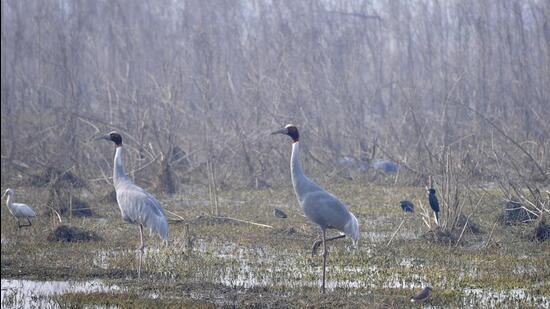Why India values wetland conservation
The Government of India accords high significance to wetlands conservation and seeks to mainstream its full range of values at all levels of developmental planning and decision-making.
World Wetland Day, which was on February 2, is celebrated worldwide to raise awareness about the critical importance of wetlands. Besides, it is also an occasion to commemorate the signing of the Ramsar Convention on Wetlands in 1971.

According to the Global Wetland Outlook by the Ramsar Convention, wetlands, among the world’s most economically valuable ecosystems and regulators of the global climate, are disappearing three times faster than forests. Yet, while a lot is known about the importance of forests, the utility of wetlands is not fully understood.
Peatlands, which account for just 3% of the world’s land surface, store twice as much carbon as forests, thus playing a crucial role in delivering global commitments on the climate crisis, sustainable development, and biodiversity. Wetlands, of course, also help reduce the risk of disasters such as floods, by protecting coastlines.
A recent compilation of species richness in coastal and marine ecosystems indicated the presence of at least 14 species of seagrasses, 69 species of mangroves (including associates), over 200 species of diatoms, 512 species of porifera, 1,042 species of cnidaria, 55,525 species of molluscs, 2,394 species of crustaceans, 2,629 species of pisces, 37 species of reptiles, 243 species of birds and 24 mammalian species.
Millions of migratory birds flock to India, and wetlands are critical to this annual phenomenon. Ecologically dependent on wetlands, migratory waterbirds connect continents, hemispheres, cultures, and societies through their seasonal movements. Migration is a period of great vulnerability, when birds experience the highest mortality rates. The “stopover” sites provide migratory birds rest, protection from predators and inclement weather before moving on to the next leg of their journey. A diversity of wetland communities offers essential stopovers for birds.
The Central Asian Flyway (CAF) is one of the nine global waterbird flyways; nearly 71% of the migratory waterbirds of the CAF use India as a stopover site. Sustaining the health of India’s wetlands is thus crucial for maintaining the waterbird populations within the flyway.
Wetlands also have a deep connection with Indian culture and traditions. Loktak Lake in Manipur is revered as “Ima” (Mother) by locals, whereas Sikkim’s Khecheopalri Lake is popular as the “wish fulfilling lake”.
The north Indian festival of Chhath is one of the most unique expressions of the association of people, culture, water and wetlands. The Dal Lake in Kashmir, Khajjiar Lake in Himachal Pradesh, Nainital Lake in Uttarakhand and Kodaikanal in Tamil Nadu are popular tourism destinations.
Despite their huge importance, wetlands are globally under threat for many reasons, including water drainage, pollution, unsustainable use, invasive species, deforestation, and soil erosion.
In India, however, we are proudly reversing the global trend of shrinking wetlands. In doing so, we continue to draw inspiration from our rich past. Wetlands find a mention even in Chankaya’s Arthashastra, where it is referred to as “anupa”, or incomparable lands, and considered sacred. With Prime Minister Narendra Modi making sustainability a key aspect of development, there has been an overall improvement in how India cares for its wetlands. As a result, the country is now a land of 49 Ramsar Sites. This is the largest network of Ramsar Sites for any country in South Asia. For those who may not know, a Ramsar Site is a wetland site designated to be of international importance.
India’s National Wildlife Action Plan (2017-2031) identifies conservation of inland aquatic ecosystems as one of the 17 priority areas, and envisages the development of a national wetlands mission and a national wetlands biodiversity register as critical interventions. In addition, integration of wetlands in river basin management has been identified as a strategy for the management of river systems.
Wetlands receive protection from several central rules and regulations. Provisions of the Indian Forest Act, 1927, the Forest (Conservation) Act, 1980 and the Indian Wildlife (Protection) Act, 1972, define the regulatory framework for wetlands located within forests and designated protected areas.
In 2017, the Union ministry of environment, forest and climate change (MoEFCC) notified the Wetlands (Conservation and Management) Rules under the Environment (Protection) Act, 1986 (EP Act). As per the provisions of these rules, state wetlands authorities have been constituted as the main policy and regulatory bodies within states.
Further, under the EP Act, coastal wetlands are protected under the Coastal Regulation Zone (CRZ) Notification (2018) and its amendments and the Island Protection Zone (IPZ) Notification 2011.
In 2020, MoEFCC took up “wetlands rejuvenation” as a transformative idea. The programme is structured around a four-pronged approach: Developing baseline information, rapid assessment of wetlands’ condition using a set of parameters in the form of wetland health cards, enabling stakeholder platforms in the form of wetland mitra (friend) and management planning.
The programme has since been upscaled to cover over 500 wetlands.
As part of the “Azadi Ka Amrit Mahotsav” celebrations and to get people’s participation in the conservation of wetlands, wetland mitras have been registered in all significant wetlands and value and threat signages have been installed in these wetlands.
A national wetlands portal has been developed as a knowledge hub on wetlands for use of all wetlands managers and stakeholders.
Wetlands not only support high concentrations of biodiversity, but also offer a wide range of important resources and ecological functions such as food, water, fibre, groundwater recharge, water purification, flood moderation, storm protection, erosion control, carbon storage and climate regulation.
The Government of India accords high significance to wetlands conservation and seeks to mainstream its full range of values at all levels of developmental planning and decision-making.
Bhupender Yadav is minister for environment, forest and climate change; and labour and employment. He is the author of The Rise of the BJP: The Making of the World’s Largest Political Party
The views expressed are personal





